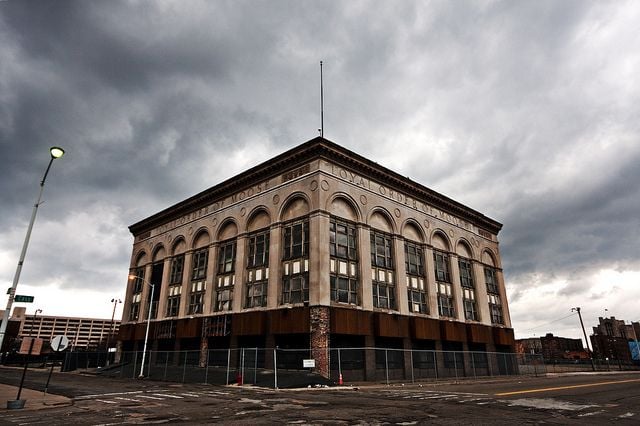The Kresge Foundation, a multibillion-dollar philanthropic organization, announced today at a press conference in the city’s famed Eastern Market that it would be awarding the City of Detroit Detroit organizations $150 million over five years to further the “Detroit Future City” initiative. Detroit Future, which was also unveiled today, is a long-range planning strategy that imagines a radical shift in how the long-ailing metropolis allocates municipal resources and treats its abundance of vacant land. The city doesn’t refer to the initiative as a plan because it already has one of those.
Instead, Detroit Future is a conceptual framework born out a 2 year community engagement process called Detroit Works. About 30,000150,000 citizens participated in that planning process, which was also funded in part by Kresge, in partnership with multiple other foundations and the city itself. Both the public planning process and the resultant strategy released Wednesday emerged partially in response to public anger over earlier recommendations that the city clear out low occupancy areas in order more efficiently reallocate municipal services.
The strategy, with its emphasis on community engagement, foundation backing and political implications is comparable to efforts made after Hurricane Katrina to create a unified vision for the city’s future. Detroit Mayor David Bing has not said how much money the city or state will contribute to the initiative. In New Orleans, the city relied on billions of dollars from FEMA and the U.S. Department of Housing and Urban Development to make the infrastructure improvements and do the blight cleanup and building envisioned in both Detroit Future City and the Unified New Orleans Plan.
Already clear in Detroit is that the massive endowment alone will not cover the initiative’s full price tag, which would likely require billions of public and private spending to reach its full scope. Nevertheless, Ben Hecht, CEO of the national urban development advocacy group Living Cities, referred to the money as “a good down payment.”
“To really think through and redesign a whole physical and economic landscape for Detroit, that’s a multibillion dollar initiative,” said Hecht. “But certainly $150 million over the next five years will give Detroit’s leaders, public and private, citizens and otherwise, some opportunities to do things that few other cities in similar situations have the ability to do.”
Hecht said that the city has changed so radically over the past few decades that a plan like Detroit Future is essential to maintaining basic municipal functionality.
“There are a lot of people who are and have been facing tough economic times. You have a lot of people who are living in parts of the city that can’t be sustained in terms of public services. It’s going to takes a lot of bold leadership from the public, private and philanthropic sectors to say ‘even though this may require a lot of hard conversations and decisions, we know this is important to the health and future of the city’,” he said.
While parts of the plan focus on dealing with the cities infamous levels of abandonment, including reverting segments of the city to wildlife preserves and courting urban faming groups, other sections look to build on top of the city’s early successes. Detroit’s rock-bottom property values are increasingly attractive to first-time homebuyers, artists and businesses. Closer to Downtown, more institutional investment has come to the Woodward Avenue area, where Twitter and Quicken Loans, Inc. have built regional offices.
Detroit Future hopes to bolster those plans, proposing big-ticket strategies like massive new parks and recreation facilities and even constructing new highways with dedicated bus rapid transit lanes to accommodate the city’s new hot spots.
However the plan actually manifests itself, Hecht believes that the Kresge fund is critical to ensuring that that discussion gets started on the right track.
“This is a lot of money you can use in early stages to bring in the right people and have the right conversations and make some initial, risky investments,” said Hecht.
_200_200_80_c1.jpg)
Ryan Briggs is an investigative reporter based in Philadelphia. He has contributed to the Philadelphia Inquirer, WHYY, the Philadelphia City Paper, Philadelphia Magazine and Hidden City.
















